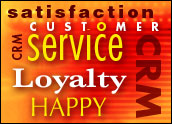
It’s not an easy task to summarize the makeup of today’s customer in a singularly defined formula. Not only do customers’ individual needs vary on a case-by-case basis, but as an aggregate whole, customers’ needs are maturing and have become much more complex and demanding than prior generations.
With this maturity comes experience. With experience comes knowledge, expectations and, as a result, the need for higher standards for service.
Cater to Customers
Regardless of your industry, what your business really boils down to is your customers, the services you provide them and the rapport your company forms with them in doing so. Because let’s face it: Without the customers, where is the business?
Companies are constantly looking for ways to not only meet these high expectations, but exceed them. One way for companies to truly take customer service to the next level is to take into consideration the element of context and how this can translate into improved customer care.
Identifying the context of a customer and his specific issue, and solving the problems laid out within the associated parameters of that specific inquiry can lead to more tailored case resolution and a more satisfied and loyal customer.
Looking for Personalization
People want not only personalized answers to their inquires, but are also looking for personalization in terms of the way they are handled by a company and its service representatives. One way in which customer context can be factored in to achieve a more tailored support process is by exposing information about the actual customer on the case forms.
Giving support technicians access to client histories, a variety of support documentation and a list of the most relevant articles pertaining to the context of the case enables them to harness this pre-existing data and use it to their advantage — both to solve the problem and make for a better customer relations environment in the process of doing so.
As an example, once a call is placed to a customer service department, a new case is created and immediately tied to the customer’s record. As soon as this correlation is established, the agent is provided with not only that individual’s order information (both past and current cases), but is also presented with supplementary information that can be helpful in solving the problem.
Adding Depth to Customization
This includes pulling information from external applications pertaining to the caller’s company, the company’s industry, tapping into publicly available financial information, recent company news or press releases, and the like.
This aggregated data which is pushed to the customer service agent immediately enables that agent to further understand who the customer is and where this inquiry falls within the larger context of the individual or company’s case history.
This creates not only a more engaging one-to-one interaction, but also adds depth to the level of customization the caller receives in the case resolution process.
Service Level Agreements
In following on this concept of pulling in pre-existing information, a second way in which a client’s account context can be incorporated into the case resolution process is to manage service level agreements (SLAs). SLAs often play an important role in the business-to-consumer relationship in that they lay out the service responsibilities that are to be delivered by the customer service organization to meet the expectations of the customer.
While SLAs can be universal in nature, an individual SLA can also be unique due to variations in the specific nature of the business-to-client relationship.
Any single SLA can include one to many different service options which define the type of service that will be available — from advanced technical support to call-in support to simple e-mail and online support — as well as the time frame during which the case should be closed and how the cases should be escalated due to predetermined prioritization.
Tailoring Resolutions
When put into practice, SLAs can play a role in the tailoring of case resolutions in a couple of ways.
First, varying parameters and levels of privileges can be applied based on an individual’s rank within a company. For example, a vice president calling in with a service request might be granted a higher level of support than an associate or administrative employee, simply based on predetermined standards in an SLA. The customer service team immediately knows what level of service should be given to this particular customer and can prioritize the customer service cycle based on this information.
Second, the available services and a customer’s privileges can vary from one company to another due to the context of the SLA. For example, a Gold level of support might encompass a variety of support options (phone-in a request, e-mail a request, specified time line for services rendered), whereas a Silver level of support would be more limited (only online services available). Having this predefined in the SLA and automatically accessible for reference allows the service representative to immediately know what format of service should be applied to the inquiry.
The Self-Service Option
One final, yet tactical, strategy which helps companies enhance personalization — without compromising internal bandwidth — is by placing the power in the customer’s hands, literally, with a customer self-service portal.
Providing this tool serves a dual role: While reducing the workload on the internal customer service department and agents, at the same time it reflects the role of the customer in the equation by enabling customers to help themselves.
A self-service tool presents an online mechanism that allows a customer to login at any time to initiate an inquiry, view his profile and the status of cases that are currently being worked on, as well as past cases and other relevant account information.
In requiring customers to identify themselves with a login and a password, the system “knows” who the customer is from the get-go and can, therefore, provide relevant information and the accompanying services that are best tailored to his needs. From there, the end-customer has direct access to the company’s knowledge base and the power and flexibility to solve the problem — or at least initiate an inquiry — at his convenience.
Streamline Data
There is, however, one caveat here. A comprehensive knowledge base is home to a plethora of data, much of which is not relevant for every single case. Therefore, when a customer searches the knowledge base, it is important that he is not inundated with useless or irrelevant documents, but rather is only presented with information that is relevant based on the context of the individual customer or the individual case.
While this may seem like a simple statement, you need to give customers what they want, not just what you think they want. Good companies today are beginning to recognize that this customer element within the overall CRM formula needs to be revisited.
However, it’s the great companies that are going a step further, adopting approaches that listen to the often overlooked voice of the customer, leveraging this feedback to implement more tailored strategies into the resolution process and, as a result, making the move from simple case management to complete, personalized customer care.
Philippe Gaillard is president and CEO of Neocase Software, a customer service software provider.













































